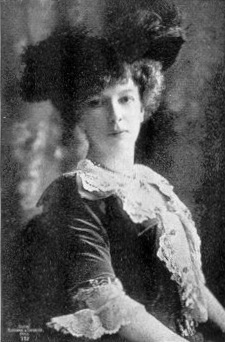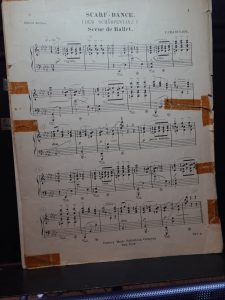I’m not sure whether my Mother taught “Scarf Dance” to me. If not, I taught it to myself as a child or early-adolescent. I have no memory of having ever performed this piece publicly. I remember that the piano-anthology/volume from which I learned the piece, was one that I never encountered during the time that I was collecting music from my parents’ estate, preparing for its closure/disposal. I only recently sorted through one of the boxes of music-items I preserved. That box of music contained a batch of sacred piano and organ music, a batch of my Mother’s compositions and arrangements that I never knew existed, and a batch of classical music that included a sheet-music version of “Scarf Dance” that was marked-up and was one of the same “Edition Beautiful” sheet-music, similar to many others that my Mother possessed and from which she received instruction while she was a music-student.
The composer’s name on my long-ago copy of “Scarf Dance” was C. Chaminade (1857 – 1944). It was not until I began rehearsing this piece to record it, when doing research for this post, that I learned (after all these years) that “C. Chaminade” was “Cécile,” a female.

When I saw Ms. Chaminade’s Wikipedia portrait, I was hauntingly-reminded of Jane Seymour’s character’s portrait in “Somewhere in Time” and the movie’s meme, “Come Back to Me…”

The sheet-music says that the tempo should be 54 beats-per-minute (b.p.m), where a half-note gets a beat. It is very unusual to specify the tempo of 3/4 meter by naming a half-note as the beat-unit. Rather, 3/4 tempos are more regularly specified as the tempo of a dotted-half, or the tempo of a quarter-note.
If the tempo-specification on the sheet-music was incorrect and it was rather intended that the tempo of a dotted-half should be 54 beats-per-minute (bpm), then the tempo of a quarter-note would be 162 b.p.m. Otherwise, if a half-note is 54 b.p.m. as specified, then a quarter-note’s tempo would be 108 bpm. At three quarter-notes per 3/4 measure, a dotted-half-note’s tempo would be 36.
I played/recorded the piece as I remembered it, without checking the tempo until after I recorded it and discovered that I performed the piece (ignoring some flexibility of tempo for phrasing) with the recording’s average tempo coming very close to the 54 bpm half-note that was specified. Additionally, my recording’s tempo seems very similar to an ancient gramophone recording from the Library of Congress.

I have had my Korg Kronos 2 for several months and have been familiarizing myself with its synthesizer-architecture and exploring its extensive internal sonic contents. This is the first time I have recorded it. My principal keyboards/synthesizers all have weighted, hammer-keyboard-actions that mimic the feel and playing-characteristics of a grand-piano. There are multiple grand-piano-sound-sets built into (the internal-memory of) the Kronos, that provide many adjustable parameters, including amount of sympathetic-string-resonance, lid-position, stereo-spread and damper-pedal-noise, to name a few.
The video was created using ProjectMilkSyphon to generate the video that is synchronized to the music. I recorded the generated video using Syphon Recorder. I then used the terminal-command ffmpeg to trim a little empty video from the beginning of the video, combine the video with the audio, and transcode the video to h264 and audio to aac. I then used Fotomagico to create titles, credits and the ending screen, and finally generate the video for this to be uploaded to YouTube. This workflow is still not automatic for me; but, it is getting easier.
I hope that you enjoy my recording of Scarf Dance.

Leave a Reply